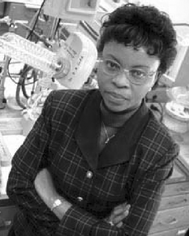Omowunmi Sadik
Scientific background and experience
Omowunmi Sadik is a Professor of Chemistry at the State University of New York at Binghamton (SUNY-Binghamton). She received her PhD in Chemistry from the University of Wollongong in Australia and did her postdoctoral research at the US Environmental Protection Agency (US-EPA) in Las Vegas, Nevada. Dr Sadik has held appointments at Harvard University, Cornell University and the Naval Research Laboratories in Washington, DC. Sadik’s research currently centers on the interfacial molecular recognition processes, sensors and biomaterials, and immunochemistry with tandem instrumental techniques. Her work utilizes electrochemical and spectroscopic techniques to study human exposure assessment, endocrine disrupters, and toxicity of naturally occurring chemical compounds. | ||
| Plate1 Omowunmi Sadik utilizes electrochemical and spectroscopic techniques to study human exposure assessment, endocrine disrupters, and the toxicities of naturally occurring chemical compounds. | ||
Sadik has over 250 scientific publications, including refereed articles, invited reviews, patents and conference abstracts. She was the co-editor of the American Chemical Society’s Symposium Series on Environmental Chemical and Biological Sensors. She has organized symposia and/or served in the organizing committees of several national and international conferences. Sadik has also lectured extensively in the USA, in European Union countries such as the United Kingdom, Germany and France, in the EU candidate countries Turkey and Romania, as well as in Africa, Japan, Australia, and New Zealand. She is the recipient of Harvard University’s Distinguished Radcliffe Fellowship, the National Science Foundation’s Discovery Corps Senior Fellowship, the SUNY Chancellor Award for Research, the Australian Merit Award, the Chancellor Award for Outstanding Inventor, and the National Research Council COBASE fellowship.
Relevant experience to the present work
Sadik is currently the director of the Center for Advanced Sensors Research and Environmental Systems (CASE) at SUNY-Binghamton. One interesting highlight of her research group is the design and fabrication of U-PAC devices involving a biosensor and a completely automated sampling system requiring minimal user interaction. The U-PAC prototype requires optional laptop for signal processing and is completely battery powered. Upon insertion of a sample, users only need to turn the pump switch on or off to record data. The rigid alignment of the sensor components and the integrated closed fluidics system provide a durable setup for field use and can easily be adapted to remote sensing to meet the needs of the field scientist and/or environmental risk assessors.Among other funding sources, Sadik’s research is supported by the US-EPA under the STAR program to design new materials for environmental detection and remediation. Her group recently reported the use of palladium nanoparticles (Pd-NPs) and their novel applications for rapid conversion of Cr(VI) to Cr(III). The real-sample application of the Pd nanoparticles/sulfur (Pd-NPs/S) mixture was tested using soil samples to produce over 92% conversion in the presence of Pd-NPs/S within one hour. In contrast, only 33% of the same concentration was converted to Cr(III) in the absence of Pd-NPs/S. This represents an over 500-fold improvement in conversion rate compared to current microbial approaches. This encouraging result is being used to develop a new nanoreactor for the remediation of heavy metals and chlorinated organics.
During her NRC Fellowship at the US-EPA’s National Exposure Research Laboratories in Las Vegas, Nevada, Sadik initiated and developed novel generic sensors and biomaterials suitable for monitoring the levels of target analytes in complex biological and environmental media. More recently, Sadik incorporated a combination of approaches and techniques to develop these multi-application sensor systems for monitoring toxic metals in the environment to detecting pathogens and biological and chemical warfare agents. Her on-going research focuses on a series of synthetic and natural phenolic estrogens for their ability to affect the viability and proliferation of lung cancer cells.
| This journal is © The Royal Society of Chemistry 2006 |
